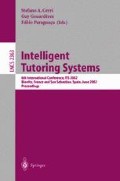Abstract
We compared two automated approaches to teaching distinguishing, a fundamental skill of case-based reasoning that involves assessing the relevant differences among cases in a context-sensitive way. The approaches are implemented in two versions of CATO, an ITS designed to teach law students basic skills of case-based legal argument. The original version of CATO employed a didactic explanatory dialogue. The newer version, CATO-Dial, teaches the same skill with a simulated dialectic argument in a courtroom setting. Our hypothesis was that students would learn better by engaging in the simulated argument than by receiving interactive explanation. We showed that students in the dialectic argument simulation group performed significantly better on certain sections of the post-test aimed at assessing transfer of their skills of distinguishing.
This material is based upon work supported by the National Science Foundation under Grant No. 9720359. We thank Professor Kevin Deasy, University of Pittsburgh School of Law, for his many contributions to this work.
Access this chapter
Tax calculation will be finalised at checkout
Purchases are for personal use only
Preview
Unable to display preview. Download preview PDF.
References
Aleven, V. (1997) Teaching Case-Based Argumentation Through a Model and Examples, Ph.D. Dis., U. Pittsburgh, unnumbered Tech. Rep. LRDC/ISP.
Aleven, V. and Ashley, K.D. (1997) “Teaching Case-Based Argumentation Through a Model and Examples’. Proc. 8th World Conf. AI in Ed. Soc. 87–94. IOS Press: Amsterdam.
Ashley, K.D., (1990). Modeling Legal Argument: Reasoning with Cases and Hypotheticals. The MIT Press / Bradford Books, Cambridge, MA.
Ashley, K. D. (2000) “Designing Electronic Casebooks That Talk Back: The CATO Program”. In Jurimetrics Vol. 40, No. 3, pp. 275–319.
Ashley, K.D. (2002) “An AI Model of Case-Based Legal Argument from a Jurisprudential Viewpoint.” In Journal of Artificial Intelligence and Law. Kluwer: Dordrecht, Neth.
Carbonell, J.R. (1970). AI in CAI: An Artificial Intelligence Approach to Computer Aided Instruction. IEEE Transactions on Man Machine Systems 11(4) 190–202.
Centinia, F., T. Routen, A. Hartmann, and C. Hegarty (1995) “STATUTOR: Too Intelligent By Half?” In Legal Knowledge Based Systems JURIX’ 95. 121–132. Lelystad: Koninklijke.
Chi, Michelene T.H., S. Silver, H. Jeong, T. Yamauchi, and R. Hausmann (2001) “Learning From Human Tutoring” in Cognitive Science, Vol. 25, pp. 471–533.
Collins, A. and Stevens, A. L. (1982). “Goals and Strategies of inquiry Teachers”. In Advances In Instructional Psychology, R Glaser (ed.) pp. 65–119. Hillsdale, NJ: Erlbaum.
Retalis, S., H. Pain and M. Haggith. (1996) “Arguing with the Devil; Teaching in Controversial Domains”. Int. Tutoring Sys., 3d Intl Conf., ITS-96. 659–667. Berlin: Springer.
Rissland, E.L. (1990) “Artificial Intelligence and Law: Stepping Stones to a Model of Legal Reasoning”. Yale Law Journal 99. 1957-1981. June 1990. Number 8.
Rose C. P., J. D. Moore, K. VanLehn, D. Allbritton. (2001) “A Comparative Evaluation of Socratic versus Didactic Tutoring”, 2001 LRDC Tech Report LRDC-BEE-1.
Span, G. (1993) “LITES, an Intelligent Tutoring System for Legal Problem-Solving in the Domain of Dutch Civil Law”. In Proc. 4th Intl Conf. AI and Law, 76–81. New York: ACM.
Thompson, L., Gentner, D. and Loewenstein, J. (2000) “Avoiding Missed Opportunities in Managerial Life.” in Org. Behavior and Human Decision Proc., 82, No. 1. May. pp. 60–75.
Wong, L., C. Quek, and C. Looi. (1997) “PADI-2: An Inquiry-based Geography Tutor”. In AI in Education, Proc. AI-ED 97 World Conf. 47–54. Amsterdam: IOS Press.
Author information
Authors and Affiliations
Editor information
Editors and Affiliations
Rights and permissions
Copyright information
© 2002 Springer-Verlag Berlin Heidelberg
About this paper
Cite this paper
Ashley, K.D., Desai, R., Levine, J.M. (2002). Teaching Case-Based Argumentation Concepts Using Dialectic Arguments vs. Didactic Explanations. In: Cerri, S.A., Gouardères, G., Paraguaçu, F. (eds) Intelligent Tutoring Systems. ITS 2002. Lecture Notes in Computer Science, vol 2363. Springer, Berlin, Heidelberg. https://doi.org/10.1007/3-540-47987-2_60
Download citation
DOI: https://doi.org/10.1007/3-540-47987-2_60
Published:
Publisher Name: Springer, Berlin, Heidelberg
Print ISBN: 978-3-540-43750-5
Online ISBN: 978-3-540-47987-1
eBook Packages: Springer Book Archive

